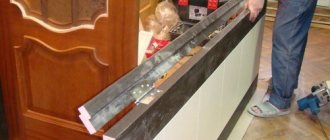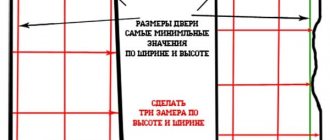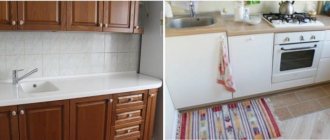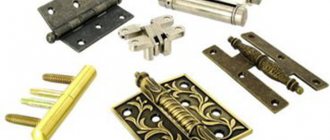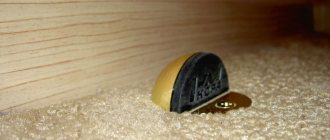The door jamb is an important element of the door structure. Manufactured according to precise rules, it ensures that the door has a supporting function and functions well. The design of the jamb is quite simple, you can even make it yourself by watching a couple of videos on YouTube on the Internet. The door jamb can be refined by covering it with special materials. The door jamb is finished using sandwich panels, plasterboard or decorative stone. You will learn further how to make a door jamb.
How to assemble a frame for an interior door
Before assembling the door frame, you need to carefully measure the opening. Even with a slight deviation, the connections between the vertical and horizontal elements will weaken. With constant mechanical load from the sash, the fasteners will quickly become unusable. As a result, installation will have to start from the beginning. It is important not to make a mistake when choosing a design. It differs depending on the purpose of the room. For example, baths and kitchens require increased moisture protection and vapor permeability. The parts must ensure active air circulation inside the threshold, upper and corner elements. The gap with the canvas is made wider than usual.
Dimensions
The dimensions of the doorway can be either standard or non-standard. Most often, the parameters of the entrance door are 800 x 2000 mm. Thus, the size of the box is 870 x 2022 mm. These are the parameters that are encountered most often.
If you decide to replace an old door, you need to take your time with the purchase. After all, entrance openings in houses with old and new layouts may differ. Often, non-standard dimensions of the door frame are found in buildings with an old layout.
The dimensions of doorways are regulated by GOST, as well as building codes and regulations (SNiP). In accordance with GOST 6629-88, the width of the doorway can be 670-1872 mm, height - 2071-2371 mm.
Materials for internal frame
- Natural solid wood - its properties depend on the quality of the wood. In the absence of defects, it has high strength and durability. The surface should be free of resin stains, chips, cracks, mold stains, and falling knots. Products change shape and size with changes in humidity and temperature. In a living room, temperature fluctuations are insignificant. To protect the workpiece from moisture, it is impregnated with antiseptics and coated with a layer of varnish.
- MDF panels do not deform or dry out over time, provided that their ends are hermetically sealed. The external stone differs little from the natural massif. Sidewalls without a decorative layer must be hidden in the seams or under the trim.
- Plastic is not afraid of water and retains its size and shape in any conditions. It can melt at a temperature of 70 degrees, so it is better to keep it at a great distance from the stove and heating appliances.
- Steel - used in private construction or for additional strengthening of the opening. The metal profile is highly durable, but quickly rusts. To protect against corrosion, use primer and paint. They delay rusting for only a few years. In addition, they are easy to damage. The most reliable means is galvanizing and copper plating in the factory. The frame is welded or assembled using screws. Using a welding machine in an apartment is highly undesirable.
Common materials for finishing doorways
High-quality finishing of doorways guarantees an aesthetic appearance, as well as sound insulation and tightness
High-quality finishing of doorways guarantees an aesthetic appearance, as well as sound insulation and tightness. Materials that are in demand for finishing doors:
- MDF panels or laminated fiberboard. These materials are durable, environmentally friendly and hygienic. They have excellent noise and heat insulation qualities.
- Drywall. Before making a jamb, you can look at photos of various modifications in advance, and you may choose the appropriate option for finishing the doorway. Drywall is an excellent alternative to plaster. This type of finishing is a simple, fast and aesthetic way to decorate a surface.
- Sandwich panels. This material has excellent noise and sound insulation properties. The most modern finishing method.
- Decorative stone finishing. Basically, this material is used to decorate door jambs without using doors, for example, arches.
- The classic option is plaster. This type of finish, in addition to its aesthetic properties, retains heat well and is highly durable.
As you can see from this article, there are many options for designing doorways. The main thing is to choose the most suitable one according to your tastes and preferences. In addition, the finishing method must meet all technical requirements and criteria, then it will delight the eye with its appearance for a very long time.
Sources:
- https://www.supersadovnik.ru/video/dvernaya-korobka-svoimi-rukami-10181
- https://goodlinez.ru/installation/613
- https://monateka.com/article/35211/
- https://jprosto.ru/kak-sdelat-dvernoy-kosyak/
Prefabricated frame elements
The frame consists of four main parts. They are beams with an L-shaped cross-section, laid along the perimeter of the opening and fixed in it with screws. The sash fits into the inner corner of the letter “L”. The parts differ in shape, size and purpose.
- Threshold - it is installed flush with the floor or made voluminous. In the first case, the canvas does not fit tightly to the bottom. In the second, the connection is more tight, especially when using seals. There are U-shaped structures without a threshold.
- Hinge posts - they hold the sash.
- Fake racks - they stand opposite the loop ones. Models with a smooth surface and with a hole for the lock cylinder are available.
- Upper support.
For normal closing and opening, gaps of 3 mm are left on each side. If there is no threshold, 10-15 mm is left below the floor. Inside, under the outer cladding, you can put a layer of hydro- and sound insulation.
When assembling the door frame of an interior door, the top and sides are covered with platbands - decorative strips. If there is free space between the platband and the frame, it is filled with an additional board - an additional decorative strip inside the opening. There are telescopic extensions that can be adjusted to any width.
Options for doing the job
There are at least a dozen options for making slopes on interior doors. Here are just some of the possible options:
- Installation of drywall sheets.
- Plastering followed by applying putty.
- Application of decorative plaster.
- Overlay panels, for example MDF.
- Wood finishing.
- Laminate lining.
- Installation of chipboard panels.
- Installation of PVC panels.
- Plastic finish.
- Finishing slopes with artificial stone.
- Installation of tiles.
The most popular options at the moment are:
- plaster followed by applying putty;
- installation of overhead panels;
- plastic finishing;
- installation of drywall sheets.
Each of these methods has its own advantages and disadvantages. The pros and cons of these slopes for interior doors are shown in the table below:
| № | Method | Advantages | Flaws |
| 1 | Plastering followed by applying putty | Can be used on any slopes, no matter how wide they are. The finishing can be varied - wallpaper, paint, and so on. | The work being performed is very dirty, and you also need to have at least basic putty skills. The crooked the slope, the more difficult it is to level it with putty. It takes time for the layers to dry; finishing requires a large number of materials and tools. |
| 2 | Installation of overlay panels | The work is done quickly, the appearance of the finished slopes is attractive, expensive and beautiful. After installing the panels, there is no need to further process the slope. | Panels are expensive. Precision and accuracy are important during installation. |
| 3 | Plastic finish | Plastic door slopes are installed quickly, are cheap, and are durable. Plastic is easy to clean. | Precision is required when working. Plastic slopes look cheap. |
| 4 | Drywall installation | Drywall provides a smooth surface; working with drywall is easy. There is a choice of final design of the slope - painting or wallpapering. | Drywall should not be used in places of high humidity. |
When you make the slopes for interior doors yourself, you should choose the option that is the most realistic in execution. Below we will provide a step-by-step guide for making slopes using the options described above.
Methods for connecting load-bearing elements
- Direct joining - the bars are placed at right angles. The edge of one rests against the end of the other. To connect planks with complex terrain, you need to cut off the protruding parts on the sidewall to which the end is applied.
- Diagonal joining - edges are cut at a 45 degree angle using a miter box or miter saw. When they are put together, they form a right angle.
Methods for fixing elements
- Screws - you should use products with a galvanized surface, which protects the metal from corrosion.
- Tenon-to-groove connection - this option is only suitable for installing wooden pieces, as well as products made of plywood and MDF. The method ensures rigid docking and is the most reliable. Only an experienced craftsman can make a tenon and cut a groove corresponding to its size.
Types of jamb coverings
- durable and reliable coating made of tiles, natural and artificial stone or mosaic;
- practical and inexpensive plastic panels;
- natural and increasingly popular bamboo panels;
- easy-to-install MDF panels;
- low-maintenance laminate.
This or that method of finishing the jamb of an entrance or interior door should be based not only on the taste preferences and material capabilities of the owner, but also take into account the practical characteristics of the future design, such as reliability and level of protection from noise and cold.
Do-it-yourself door frame assembly
As an example, let's look at how to properly assemble a U-shaped door frame yourself. A threshold protruding beyond the floor level is rarely used in the interior. It is usually installed at the entrance to the home and serves to strengthen the frame.
Tools for work
- Roulette, ruler and corner.
- Construction level and plumb line.
- Solid wood spacers and wedges, trimmings of beams and boards.
- A grinder with a disk for cutting wood or a hacksaw.
- To cut workpieces at a 45 degree angle, you will need a miter saw. For this, they also use a miter box - a trench with slots for the saw blade located on its sides.
- Hammer and nails.
- Screwdriver, screwdriver and self-tapping screws.
- Chisel.
- Polyurethane foam.
- Clamp - it is used to press the glued parts together.
Preparing the base
The opening is cleared of old materials and, if necessary, its surface is leveled. The cracks are expanded and filled with cement mortar. Grease stains are wiped off with alcohol. The inner sides are impregnated with antiseptics to prevent the formation of mold. Measurement of internal faces is carried out after their preparation is completed.
Some recommendations
Tools required for work: tape measure, level, spatulas, screwdriver, metal scissors, grinder.
Immediately before starting work, you need to prepare your tools. This:
- spatulas;
- level;
- roulette;
- metal scissors;
- screwdriver;
- empty containers;
- Bulgarian;
- marker, etc. (depending on option).
Before you start finishing the slopes, it is important to make them smooth using plaster or drywall. Despite the fact that plastering is a rather labor-intensive task, it has excellent results, since the plaster is more durable
Compared to plasterboard, the wall and slope do not form voids, which will subsequently affect the thermal characteristics. In order for plastering to be done properly, it is necessary to use beacons along which the plaster is leveled.
When the question arises of how to finish the slopes of the front door, you should take into account the factors that are taken into account when choosing materials for finishing. Finishing the door jambs
Finishing the door jambs.
You should select a material for decorative finishing of entrance door slopes not only for its aesthetic qualities, but also take into account its properties. For example:
- Such parts of entrance doors are exposed to dust and dirt from the inside, so the material should be easily and quickly washed.
- Due to sudden temperature changes, elements are exposed to moisture, which is certainly expressed in the form of condensation on their surface. Certain building materials deteriorate from moisture, which further leads to deterioration. Therefore, it is better to plaster the products rather than cover them with plasterboard. This especially applies to private houses, where the entrance doors naturally come into contact with the street.
- The slopes of the front door are easily damaged under the mechanical influence of objects that are brought into the house. Therefore, the material must withstand mechanical damage.
So, the most suitable materials include wood, laminated panels and natural or artificial stone.
Features of getting started
To make a door jamb, first prepare the tools:
- level;
- hacksaw;
- roulette;
- plumb line;
- pencil or marker;
- chisel;
- plane;
- axe.
Scheme of foaming a door frame into a wall opening.
To make a door frame, it is necessary to prepare thick logs. If you already have certain skills in the construction field, then this will not be difficult; if you do not have them, you should trust the specialists.
First of all, the logs are laid out with wedges onto 2 or 4 blocks. After this, four-rope beams are turned from the resulting blocks: on one side, a groove is made on it for fastening to the wall, and on the other side, one quarter is removed, into which the door leaf will subsequently fit.
Tenons are cut out from the ends of the logs, which should correspond in size to the grooves on the beam. The fit must be done very precisely, since, apart from the tenons, the door frame is not secured with anything else.
Usually wooden doors are chosen for a house, but since they are the heaviest, they can turn the decks inside out when fully opened. This leads to the door not closing tightly, which in turn causes loosening. If the grooves are poorly fitted, the defective door frame will begin to manifest itself immediately: loosening will begin, the formation of cracks through which the room will be blown.
After all the preparatory work, they proceed directly to installing the door frame in its rightful place. On both sides, the width of the door frame is made equal to the depth of the tenon (fastening). The depth of the tenon will depend on the width of the decks. After this, two development options are possible.
Assembly diagram of a door frame for a log building.
In the first case, an opening is cut out along the manufactured door frame; in the second case, the opening is first cut out, and the door frame is made directly under it. Some professionals, over many years of practice, have developed the ability to do everything “by eye.”
The hole is made using a plumb line to accurately determine the vertical on the log house and everything is marked with lines that will mark the future opening. Using a level, they also mark the top and bottom, after which they begin to saw through the doorway according to the markings. If the sawn element is wide, then sawed off bars will help you install the deck, which will act as a kind of wedges. Thanks to this, the doorway can be not only rectangular, but even trapezoidal.
Finishing slopes near the front door
The most expensive and luxurious door will lose its beauty if the slopes are not carefully finished. And the task is to make them look beautiful, fit into the overall style of the hallway and corridor, and be practical.
Before decorating, slopes must be leveled with plaster or covered with plasterboard. However, if you chose decorative stone or brick to decorate the slopes of the front door inside the apartment, plasterboard sheets may not withstand the weight of the finish.
Therefore, plaster, and with the addition of alabaster, is attached to the wall securely and quickly.
The pattern on the door is repeated on the walls.
The finishing of the slopes continued in the hallway
The principle of gluing slopes is practically no different from finishing work in an apartment.
- Laminate and MDF panels require a flat surface if the width of the slope is very large. If it is narrow, then some errors will not be a hindrance. They are attached to a thin layer of mounting foam, which fills the space between the material and the wall.
- It is not recommended to use plastic for slopes due to its fragility and cheap appearance.
- Clinker tiles in the form of bricks will be appropriate in both houses and apartments.
- Finishing stone is not cheap, but it also looks presentable and expensive. It is attached with liquid nails or special resin.
Not only the slopes, but also the walls are finished with stone
The slopes are not wide, so their finishing is minimal
Tip: using clinker bricks or stone, use these materials to decorate not only the slopes, but also the outer corners, the part of the wall in which the front door is located. Then the doorway will not stand out too much.
We have already talked about options for decorating the hallway with decorative stone. The same tips for choosing a design apply to the design of slopes.
And I would like to add that in a private house it is undesirable to use MDF panels, veneer, vinyl artificial leather, or plasterboard in the doorway.
Behind the outer wall there is already a street, and this is fraught with the formation of condensation, mold and subsequent damage to finishing materials. Stone or brick is preferable.
Reconstruction of door jambs and doors
During the renovation, each of you has faced the problem of completely replacing the door frame or a small reconstruction that can completely transform the appearance of your door.
The presence of a wooden door in the house gives a lot of scope for the imagination of the homeowner. The simplest method of restoration may be to grind the surfaces. Using sanding, you can level the surface and get rid of small chips and cracks. Sanding can remove not only paint, but also varnish. After the work is completed, the surface is cleaned of dust and reconstruction continues.
If there are deep cracks or gouges on the door, they must be smoothed out.
Door set diagram.
This work is done with a spatula using a special composition - wood putty. The mixture is produced both in a ready-to-use composition and in a powder that will need to be diluted.
After the surface is puttied, you need to wait for it to dry completely, and then perform another stage of sanding. If the door cannot be restored, then it can be completely closed, for example, with a sheet of chipboard. This option is one of those that is called “cheap and cheerful”.
The only problem with this option is the weight of the structure, but not critical. The chipboard sheet must be adjusted very precisely so that it does not interfere with opening and closing the system.
After all the work has been done, further decor depends only on your imagination: the door can be painted in any color, decorated with putty or covered with wallpaper. In any case, the design will depend on the general mood of the room and your imagination. After finishing the decoration work, the door is varnished, which will significantly increase its service life.
Source: dekormyhome.ru
Slopes from the outside
Front door slopes: how to make the work more understandable?
You need to break it down into stages:
If the gap between the door frame and the wall was sealed with foam, re-foaming is necessary if necessary. To check the gap for ventilation, you can use a lighter: close the door and carry the burning lighter across the entire profile. If the seam shows through somewhere, the flame will clearly stir, then the seam will need to be sealed.
After the polyurethane foam has hardened, you need to cut it off and begin finishing. If the seams were sealed with cement, there should most likely not be any blowing. But if the gap between the wall and the door is not sealed in any way, then this operation is best carried out exclusively with a mixture of cement on an adhesive base, but with mounting foam.
So, after sealing the gap, we seal it
Please note that sealing the foam in the gap should be done with cement, not putty or plaster.
After the cement mixture has hardened, the platbands are installed. The selection of door frames is carried out according to the design and color of the door (see
Design of interior doors). It is better to fasten the platbands using special brackets. The platbands not only have decorative functions, but also cover the installation gap, which means they protect the locks and mounting pins from breaking.
The slopes on the outside are also sealed with cement. First of all, you need to clean them of old coating and debris. Next, you need to cover them with a layer of primer and wait until it dries. Afterwards, a layer of cement should be applied to level the walls. If there are unevenness on the surface of the wall, they need to be reduced to zero.
Painting. The simplest option for finishing the surface of external slopes is to paint them. If there is a desire for more elegant solutions, then finishing with plastic or laminate is possible.
What is a door frame for?
The door frame is a part of the structure in the doorway that ensures the correct installation of the door. In appearance it resembles a frame. Without door frames it is impossible to install interior doors.
Metal hinges are attached to the door frame, on which the door will be mounted, as well as a mortise plate for a lock or latch. The condition of the entire structure with a wooden door depends on how well the frame is made and how well it is installed.
Door frame ensures proper door installation
When measuring the frame, you need to take into account the weight of the door leaf, which will bear the load on the door frame.
The door frame consists of three parts - two side and one transverse. If necessary, you can make a threshold. Although now neat metal thresholds are installed on floor coverings, which can be purchased along with laminate or linoleum.
To make a door frame yourself, you should start by taking the necessary measurements and selecting the material.
Some nuances when installing platbands
It is necessary to install platbands or a finishing frame on the doorway, the finishing of which will give a finished and aesthetic appearance to the structure. You can select the necessary platband from a large number of standard ones presented in a hardware store. They are fastened using finishing and liquid nails and self-tapping screws. Some tips that will make the process of installing trim on doorways easier:
- Heads of screws/nails or small cracks can be hidden using a wax corrector or acrylic-based sealant.
- Gaps where the planks meet each other can be eliminated with a single finishing nail.
- Large defects in the door frame can be hidden with wider trims.
Door jamb: measurements and choice of material
Let's start with the fact that you need to choose the right timber (lut) in the store. It should match the width of the wall into which the box is inserted. Luts come in different types, with different coatings and in all suitable sizes.
The materials from which the loot is made also vary:
If you buy it in the same place as the door, you will be offered an identical loot, which will be no different from the door. Door manufacturers often launch the production of wooden blanks for door frames. For the front door, it is better to choose a frame made of solid oak - it is more reliable and durable than MDF.
Before you start making the door frame, you need to take measurements
If suddenly the width of your wall is not standard and none of the proposed options are suitable, take a beam slightly narrower than the wall, and the remaining width can be compensated for by a good-quality board.
When the materials are ready and the tools are available, we move on to making the box.
Making a box begins with taking measurements. If desired, you can draw a drawing. Measurements are taken after the old frame has been dismantled and the opening has been repaired - the unevenness in the wall has been puttied. First you need to take measurements of the height of the future structure and the width of the doorway. It is not advisable to exceed the size of the loot, as this will make it more difficult to file off the extra pieces.
What is the best way to finish the slopes of the front door?
Having looked at the new, just installed door, we come to the conclusion that, unfortunately, the work did not end there.
From the outside, everything looks quite luxurious and beautiful, which cannot be said about the hallway of the apartment. Bare concrete or brick walls and polyurethane foam are far from pleasing to the eye. In order to fix this, it is necessary to complete the work on the front door by beautifully finishing its slopes. The problem is that there are several options for solving this problem, but this article will help you choose the right materials and also explain how to install them correctly yourself.
So, here are the main finishing methods:
In order to choose the option that is right for you and the interior of your home, we will consider separately the disadvantages and advantages of each of them.
How to make a door frame yourself
To make a box of standard sizes, you will need three purchased timbers. Two of them will go to the racks, one will be cut into the upper crossbar and threshold.
The threshold may not be installed, in this case the required length will be cut from the whole beam, and the rest will go to waste.
The height of the racks is not difficult to determine; they can be the height of the entire opening in the wall. However, no less than the height of the door with upper and lower gaps (2-3mm), as well as double the thickness of the door at its thinnest point. If the frame does not have a threshold, then the thickness is only of the top crossbar in the thinnest place (where it is embedded under the door). But then the gap from below should be increased to at least 20 mm.
The process of making a door frame with your own hands
The length of the top crossbar should include the width of the door with two small distances (2-3 mm each). Similarly with the threshold (if you decide to install it).
In order to connect all the parts of the box together, it is necessary to make several cuts on the upper (lower) crossbar. You need to remove a small piece from the thick part of the loot. To do this, it is better to place all the parts on the floor and combine them into the future box.
When docking, it will become clear what exactly is preventing a tight connection. When sawing off excess pieces of loot, it is important not to damage the coating of the box.
Why the jambs bend all the reasons
You know that door frames are made of wood. And, as everyone knows, wood absorbs moisture excellently. Of course, the outside of the jambs is covered with varnish. And this, as a rule, should protect the material from water. But this is all because the varnish is highly permeable to moisture.
In the end, the following diagram comes out. By eating moisture, the tree becomes larger in size. And when it gives it away, its size becomes smaller. The process is natural – but nasty.
Installation of jambs
Because the tree has a heterogeneous structure, it becomes larger and less heterogeneous. As a result, the jambs bend.
This is the main, only one and main reason for the difficulty. How to resolve it? Yes, very easy! The jambs should be properly attached. Then they will remain in their place under any circumstances, even under the influence of external factors.
Do-it-yourself door frame: assembly of the structure
Once all the parts are adjusted, you can proceed to assembling the box. It is also easier to assemble it on the floor.
Loot assembly:
- Before connecting with screws or nails, you should drill holes for future screws or nails. This is necessary to prevent the tree from bursting.
- After connecting all the parts, it is better to test yourself by placing the box in the door.
- Check all the gaps, and in this position it is convenient to make markings for future hinges.
- Perhaps it will be more convenient to embed the hinges and lock before installing the box, and after installation, simply assemble everything, like a construction set.
When all the door frame parts are ready, you can begin assembly.
There is another option for connecting the box parts by cutting them at an angle of 45 degrees. This option is also not bad, but additional accuracy is required.
Sections can be made using a miter box or special tools.
The finished parts of the MDF door frame can be covered with PVC film or veneered. If the loot is made of natural wood, it can be varnished or painted with any paint.
Finishing slopes with plaster
Now we will look at the classic processing method, which is best suited for the front door. So, let's look at its advantages:
- Plastered edges are excellent insulation materials. They are quite unpretentious in maintenance, and can also be called durable without undue modesty.
- The processed box looks very solid.
- Considering the fact that there are a lot of options for plastering slopes, accordingly such slopes will be very original.
- Due to its durability, this finish will last a long time.
But along with the advantages, there are also disadvantages:
- There will be a large amount of dirt and debris in your apartment. If you choose this finishing option, you can't wallpaper it before you finish the door.
- Construction mixtures take a long time to dry, so finishing work will take time, about 2-3 days.
Required tools and materials:
- Construction rule.
- Masking tape, beacons.
- Cement, sand, primer.
- Putty, spatula, trowel.
- Level, sandpaper, brush.
Step 1: Prime the wall completely.
to avoid the appearance of fungus. To do this, dilute the primer as indicated on its packaging and apply it to the wall in an even layer and wait until it dries. Step 2. Next you need to set the beacons. why dilute a little thick solution. Laying small parts of it on the wall, insert guide beacons into them using a level.
Step 3. Mix cement with sand (ratio 1 to 4). This solution should be used to cover the deepest places and potholes. After waiting for the solution to dry, take the rule and level the slope. To do this, distribute the solution over the beacons. Do the same with the rest of the slopes.
Step 4: Wait for everything to dry. Putty the slope and rub the putty with the finest sandpaper.
Step 5. Cover the doorway with wallpaper or paint it.
Wooden door frame: installation of a finished structure
Once the box is assembled, you can begin installation. You need to have a hammer, self-tapping screws, a hammer drill, polyurethane foam and wooden wedges on hand.
Progress:
- We insert the box into the opening. If the box has small gaps with the opening, then you are very lucky.
- If the loot has a special removable bar behind which you can hide the bolts, then this is a second success.
- In this case, we level the box, put wedges between the wall and the box so that it does not wobble, and use a hammer drill to drill a hole through the hole into the wall.
- There should be at least 3 connections on the posts, and 1-2 on the lower and upper crossbars.
- After this, fill the gaps between the box and the wall with foam. After drying, cut off the foam at the base with the wall and install the door and trim.
There are cases that after assembling the box, it does not fit tightly in the opening - there are gaps of 2-3 cm or more.
The door frame installation process can be carried out after it has been assembled
In this case, the installation is a little more complicated:
- You need to get wooden wedges 2 mm thick.
- Before inserting the frame, you must insert the door into it. It is not necessary to secure it with all the screws in the hinges, but it should still stand in its place.
- We place the box together with the door in the opening. Secure with wide pegs to level.
- Make sure that the box is not only level, but also does not fly out or sink over the edges of the wall.
- We close the door from the outside and secure it with wedges around the perimeter. We pay special attention to the middle of the racks and the top crossbar.
- After installing all the wedges, we fill in the gaps between the core and the wall with polyurethane foam.
Blow out the foam carefully so that when it dries, it does not expand the container so that the doors then cannot open and close freely.
Before blowing, for better adhesion of the foam, get rid of dust using water or a primer.
After the foam has completely dried (about a day), we cut off the foam, remove the wedges from the door, and check the work. The final touch is to attach the locks and platbands.
How to beautifully make slopes outside and inside the apartment
To design openings, installation is required:
- slopes;
- platbands;
- thresholds.
Sometimes, before facing, the surface is plastered or covered with plasterboard. The decoration is made up of trims and tiles.
Plaster
The entrance door slopes are plastered before finishing. Alabaster, gypsum, perlite or decorative compositions are recommended. Even with labor-intensive installation, they are heat-resistant and aesthetically pleasing. Treatment with antiseptics is required to prevent the formation of fungus. Features of plaster finishing:
- the surface is moistened, primed in 2 layers;
- a rule is hung along the edge of the slopes according to the level;
- plaster mortar is poured on, leveled with the rule;
- external corners are rubbed or leveled with a perforated corner;
- the plaster is applied in 2–3 layers with a break for drying;
- to form even corners, metal beacons can be installed, which are supported by a rule;
- after drying, the rule moves to the left, the aligned corners are rubbed over.
Important Before facing, plastered slopes are puttied. An angle spatula can be used to form corners
Then the installation of beacons will not be required. To prevent the mixture from falling from a vertical slope, a reinforcing mesh is installed.
Video about how door slopes are plastered:
Installation of accessories
The extensions form an integral structure in the door niche, which does not require separate installation of slopes and trims. Allows you to hide significant distortions and unevenness of the opening. Single-color and telescopic elements are produced, connected by a tongue and groove. The accessories are made from:
- MDF;
- wood;
- plastic.
Installation process on a door frame without grooves:
- vertical and horizontal planks are assembled into a structure in the shape of the letter “U”, fixed with self-tapping screws;
- the prepared box is installed in a niche;
- in the opening (between the wall and the structure), the box is compacted with spacer bars, which are driven in with a hammer;
- expansion joints are filled with polyurethane foam;
- the structure is framed with platbands installed in a tongue and groove.
Additional platbands are often solid structures in the shape of the letter “P”. Collapsible elements must be sharpened by 45 degrees at corner joints. To do this you will need a miter box and a wood saw.
Video about installing door panels:
Plasterboard structures
Drywall is used to prepare the base for finishing slopes. It is fire resistant, low weight, easy to install and affordable, but cannot withstand impact loads. The problem is solved by panel or tile cladding. Stages of work:
- measure the height, length and width of the niche;
- make blanks by cutting out slopes with a wood saw;
- Drill holes for self-tapping screws on concrete and workpieces;
- fix the vertical bar with self-tapping screws, checking with a building level;
- install the longitudinal strips in the same way;
- Fill the gaps between the slopes and the door with foam.
Attention When marking workpieces, reduce the width by 2–3 cm from one edge to leave room for the mounting foam. Then the seams are plastered and masked under the cladding.
Tiling
The tiles are used both for decorating slopes and for arranging thresholds. Entrance doors are often decorated with concrete thresholds that require cladding. The tiles are fixed with tile adhesive. The gaps between the floor and the door are first filled with polyurethane foam. The seams between the slopes and the frame are sealed in the same way. Process:
- the surface is primed in 2–3 layers;
- tiles are laid on a dry surface, taking into account the seams, the pattern is marked with a construction pencil;
- apply the adhesive composition with a thickness of 5–10 mm using a notched trowel;
- the tiles are laid on the mortar and moved until they fit tightly;
- after 48 hours, the seams are filled with grouting solution;
- after 30 minutes, the remnants of the grout are removed;
- the seams are sealed with acrylic or silicone sealant.
Tip To maintain the distance between elements, you can use spacer crosses. They are removed before grouting after the glue has dried.
Entrance groups are designed in conjunction with door trim and opening decoration. Doors are paneled, covered with films or painted. Entrance niches are sealed with plasterboard or plaster and then decorated. Extensions are installed as a universal option.
